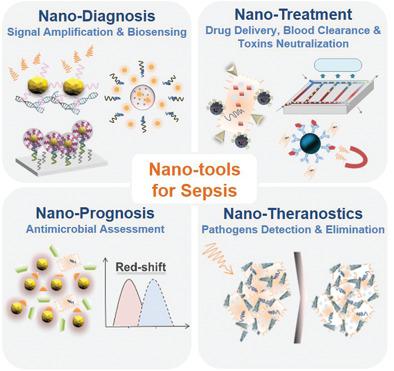当前位置:
X-MOL 学术
›
Adv. Healthcare Mater.
›
论文详情
Our official English website, www.x-mol.net, welcomes your
feedback! (Note: you will need to create a separate account there.)
Nanotools for Sepsis Diagnosis and Treatment
Advanced Healthcare Materials ( IF 10.0 ) Pub Date : 2020-11-25 , DOI: 10.1002/adhm.202001378 Lana Papafilippou 1 , Andrew Claxton 2 , Paul Dark 3 , Kostas Kostarelos 1, 4 , Marilena Hadjidemetriou 1
Advanced Healthcare Materials ( IF 10.0 ) Pub Date : 2020-11-25 , DOI: 10.1002/adhm.202001378 Lana Papafilippou 1 , Andrew Claxton 2 , Paul Dark 3 , Kostas Kostarelos 1, 4 , Marilena Hadjidemetriou 1
Affiliation

|
Sepsis is one of the leading causes of death worldwide with high mortality rates and a pathological complexity hindering early and accurate diagnosis. Today, laboratory culture tests are the epitome of pathogen recognition in sepsis. However, their consistency remains an issue of controversy with false negative results often observed. Clinically used blood markers, C reactive protein (CRP) and procalcitonin (PCT) are indicators of an acute‐phase response and thus lack specificity, offering limited diagnostic efficacy. In addition to poor diagnosis, inefficient drug delivery and the increasing prevalence of antibiotic‐resistant microorganisms constitute significant barriers in antibiotic stewardship and impede effective therapy. These challenges have prompted the exploration for alternative strategies that pursue accurate diagnosis and effective treatment. Nanomaterials are examined for both diagnostic and therapeutic purposes in sepsis. The nanoparticle (NP)‐enabled capture of sepsis causative agents and/or sepsis biomarkers in biofluids can revolutionize sepsis diagnosis. From the therapeutic point of view, currently existing nanoscale drug delivery systems have proven to be excellent allies in targeted therapy, while many other nanotherapeutic applications are envisioned. Herein, the most relevant applications of nanomedicine for the diagnosis, prognosis, and treatment of sepsis is reviewed, providing a critical assessment of their potentiality for clinical translation.
中文翻译:

用于脓毒症诊断和治疗的纳米工具
败血症是世界范围内主要的死亡原因之一,其高死亡率和病理复杂性阻碍了早期和准确的诊断。如今,实验室培养测试已成为败血症中病原体识别的缩影。但是,它们的一致性仍然是一个有争议的问题,经常观察到假阴性结果。临床使用的血液标志物,C反应蛋白(CRP)和降钙素(PCT)是急性期反应的指标,因此缺乏特异性,诊断效力有限。除诊断不佳外,药物递送效率低下和耐药性微生物患病率上升也构成了抗生素管理的重大障碍,并阻碍了有效的治疗。这些挑战促使人们探索寻求准确诊断和有效治疗的替代策略。出于诊断和治疗目的,对败血症中的纳米材料进行了检查。能够捕获生物流体中败血症病原体和/或败血症生物标志物的纳米颗粒(NP)可以彻底改变败血症诊断。从治疗的观点来看,目前已经存在的纳米级药物递送系统已被证明是靶向治疗的优秀盟友,同时还设想了许多其他的纳米治疗应用。在本文中,综述了纳米药物在脓毒症的诊断,预后和治疗中最相关的应用,从而对其在临床翻译中的潜力提供了重要的评估。能够捕获生物流体中败血症病原体和/或败血症生物标志物的纳米颗粒(NP)可以彻底改变败血症诊断。从治疗的角度来看,目前已有的纳米级药物递送系统已被证明是靶向治疗的优秀盟友,同时还设想了许多其他的纳米治疗应用。在本文中,综述了纳米药物在脓毒症的诊断,预后和治疗中最相关的应用,从而对其在临床翻译中的潜力提供了重要的评估。能够捕获生物流体中败血症病原体和/或败血症生物标志物的纳米颗粒(NP)可以彻底改变败血症诊断。从治疗的角度来看,目前已有的纳米级药物递送系统已被证明是靶向治疗的优秀盟友,同时还设想了许多其他的纳米治疗应用。在此,对纳米药物在脓毒症的诊断,预后和治疗中最相关的应用进行了综述,对它们在临床翻译中的潜力提供了重要的评估。同时设想了许多其他的纳米治疗应用。在本文中,综述了纳米药物在脓毒症的诊断,预后和治疗中最相关的应用,从而对其在临床翻译中的潜力提供了重要的评估。同时设想了许多其他的纳米治疗应用。在本文中,综述了纳米药物在脓毒症的诊断,预后和治疗中最相关的应用,从而对其在临床翻译中的潜力提供了重要的评估。
更新日期:2021-01-06
中文翻译:

用于脓毒症诊断和治疗的纳米工具
败血症是世界范围内主要的死亡原因之一,其高死亡率和病理复杂性阻碍了早期和准确的诊断。如今,实验室培养测试已成为败血症中病原体识别的缩影。但是,它们的一致性仍然是一个有争议的问题,经常观察到假阴性结果。临床使用的血液标志物,C反应蛋白(CRP)和降钙素(PCT)是急性期反应的指标,因此缺乏特异性,诊断效力有限。除诊断不佳外,药物递送效率低下和耐药性微生物患病率上升也构成了抗生素管理的重大障碍,并阻碍了有效的治疗。这些挑战促使人们探索寻求准确诊断和有效治疗的替代策略。出于诊断和治疗目的,对败血症中的纳米材料进行了检查。能够捕获生物流体中败血症病原体和/或败血症生物标志物的纳米颗粒(NP)可以彻底改变败血症诊断。从治疗的观点来看,目前已经存在的纳米级药物递送系统已被证明是靶向治疗的优秀盟友,同时还设想了许多其他的纳米治疗应用。在本文中,综述了纳米药物在脓毒症的诊断,预后和治疗中最相关的应用,从而对其在临床翻译中的潜力提供了重要的评估。能够捕获生物流体中败血症病原体和/或败血症生物标志物的纳米颗粒(NP)可以彻底改变败血症诊断。从治疗的角度来看,目前已有的纳米级药物递送系统已被证明是靶向治疗的优秀盟友,同时还设想了许多其他的纳米治疗应用。在本文中,综述了纳米药物在脓毒症的诊断,预后和治疗中最相关的应用,从而对其在临床翻译中的潜力提供了重要的评估。能够捕获生物流体中败血症病原体和/或败血症生物标志物的纳米颗粒(NP)可以彻底改变败血症诊断。从治疗的角度来看,目前已有的纳米级药物递送系统已被证明是靶向治疗的优秀盟友,同时还设想了许多其他的纳米治疗应用。在此,对纳米药物在脓毒症的诊断,预后和治疗中最相关的应用进行了综述,对它们在临床翻译中的潜力提供了重要的评估。同时设想了许多其他的纳米治疗应用。在本文中,综述了纳米药物在脓毒症的诊断,预后和治疗中最相关的应用,从而对其在临床翻译中的潜力提供了重要的评估。同时设想了许多其他的纳米治疗应用。在本文中,综述了纳米药物在脓毒症的诊断,预后和治疗中最相关的应用,从而对其在临床翻译中的潜力提供了重要的评估。











































 京公网安备 11010802027423号
京公网安备 11010802027423号